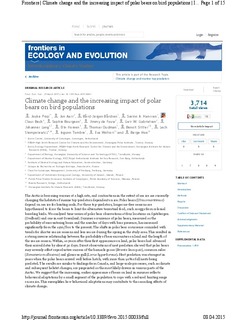Climate change and the increasing impact of polar bears on bird populations
Prop, Jouke; Aars, Jon; Bårdsen, Bård-Jørgen; Hanssen, Sveinn Are; Bech, Claus; Bourgeon, Sophie; Fouw, Jimmy de; Gabrielsen, Geir W.; Lang, Johannes; Noreen, Elin; Oudman, Thomas; Sittler, Benoit; Tombre, Ingunn; Wolters, Eva; Moe, Børge; Stempniewicz, Lech
Peer reviewed, Journal article
Permanent lenke
http://hdl.handle.net/11250/284798Utgivelsesdato
2015Metadata
Vis full innførselSamlinger
- Publikasjoner fra CRIStin - NINA [2364]
- Scientific publications [1392]
Sammendrag
The Arctic is becoming warmer at a high rate, and contractions in the extent of sea ice are currently changing the habitats of marine top-predators dependent on ice. Polar bears (Ursus maritimus) depend on sea ice for hunting seals. For these top-predators, longer ice-free seasons are hypothesized to force the bears to hunt for alternative terrestrial food, such as eggs from colonial breeding birds. We analyzed time-series of polar bear observations at four locations on Spitsbergen (Svalbard) and one in east Greenland. Summer occurrence of polar bears, measured as the probability of encountering bears and the number of days with bear presence, has increased significantly from the 1970/80s to the present. The shifts in polar bear occurrence coincided with trends for shorter sea ice seasons and less sea ice during the spring in the study area. This resulted in a strong inverse relationship between the probability of bear encounters on land and the length of the sea ice season. Within, 10 years after their first appearance on land, polar bears had advanced their arrival dates by almost 30 days. Direct observations of nest predation showed that polar bears may severely affect reproductive success of the barnacle goose (Branta leucopsis), common eider (Somateria mollissima) and glaucous gull (Larus hyperboreus). Nest predation was strongest in years when the polar bears arrived well before hatch, with more than 90% of all nests being predated. The results are similar to findings from Canada, and large-scale processes, such as climate and subsequent habitat changes, are pinpointed as the most likely drivers in various parts of the Arctic. We suggest that the increasing, earlier appearance of bears on land in summer reflects behavioral adaptations by a small segment of the population to cope with a reduced hunting range on sea ice. This exemplifies how behavioral adaptations may contribute to the cascading effects of climate change.
cascading effects, colonial breeding birds, depredation, global warming, polar bear, seabirds, sea ice
